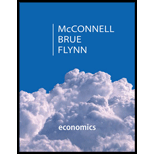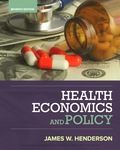
Subpart (a):
The preventive health care cost effectiveness.
Subpart (a):
Answer to Problem 3P
The total cost of 100 tests is $10,000. The total future medical expense averted is $15,000. The medical expense saved after setting up of the screening system is $5,000.
Explanation of Solution
The preventive health care measures are those medical precautionary measures which help the people to stay healthy and free from diseases. The screening system helps the people to easily identify and detect various diseases in their early stages which will help them to treat the diseases easily and affordably without much hassle.
The cost of one screening test is $100 according to the given information and the number of persons taking the screening test is 100. Thus, the total cost of taking the medical screening test can be calculated by multiplying the cost per screening test with the total number of persons taking the screening test as follows:
Thus, the total expense of 100 screening tests is $10,000.
The given percentage of persons having the test result positive is 15%. Thus, the total number of persons having positive test results can be calculated by multiplying the total number of persons with the given percentage as follows:
Thus, there will be 15 persons having the positive results from the screening test.
The amount of the future medical expense saved by the individual when the test result is positive is $1,000. Thus, the total future medical expense that can be saved by the people having the positive test results can be calculated by multiplying the per person medical expense saved with the total number of persons having positive test results as follows:
Thus, the total future medical expense saved by the persons having the positive test results is $15,000.
The cost of setting up the screening system is $10,000 and the total future medical expense saved is $15,000. Thus, the net future medical expense saved can be calculated by subtracting the cost of setting up the screening system from the total medical expense saved as follows:
Thus, the net medical expense saved after reducing the cost of setting up the screening test is $5,000.
Concept introduction:
Preventive health care: They are the measures taken in order to prevent the occurrence of a disease rather than treatment of a disease.
Sub part (b):
The net medical expense loss after reducing the cost of screening test.
Sub part (b):
Answer to Problem 3P
The total cost of 100 tests is $10,000. The total future medical expense averted is $5,000. The medical expense lost after setting up of the screening system is -$5,000.
Explanation of Solution
The cost of one screening test is $100 according to the given information and the number of persons taking the screening test is 100. Thus, the total cost of taking the medical screening test can be calculated by multiplying the cost per screening test with the total number of persons taking the screening test as follows:
Thus, the total expense for 100 screening tests is $10,000.
The given percentage of persons having the test result as positive is 5%. Thus, the total number of persons having positive test results can be calculated by multiplying the total number of persons with the given percentage as follows:
Thus, there will be 5 persons having the positive results from the screening test.
The amount of the future medical expense saved by the individual when the test result is positive is $1,000. Thus, the total future medical expense saved by the people having the positive test results can be calculated by multiplying the per person medical expense saved with the total number of persons having positive test results as follows:
Thus, the total future medical expense saved by the persons having the positive test results is $5,000.
The cost of setting up the screening system is $10,000 and the total future medical expense saved is $5,000. Thus, the net future medical expense saved can be calculated by subtracting the cost of setting up the screening system from the total medical expense saved as follows:
Since the result is having a negative sign, it shows that the expense of setting up the screening system is higher than the benefit received from the use of the screening system. Thus, the net result is a loss. Thus, the net medical expense loss after reducing the cost of setting up the screening test is -$5,000.
Want to see more full solutions like this?
Chapter 22 Solutions
EBK ECONOMICS
- PART II: Multipart Problems wood or solem of triflussd aidi 1. Assume that a society has a polluting industry comprising two firms, where the industry-level marginal abatement cost curve is given by: MAC = 24 - ()E and the marginal damage function is given by: MDF = 2E. What is the efficient level of emissions? b. What constant per-unit emissions tax could achieve the efficient emissions level? points) c. What is the net benefit to society of moving from the unregulated emissions level to the efficient level? In response to industry complaints about the costs of the tax, a cap-and-trade program is proposed. The marginal abatement cost curves for the two firms are given by: MAC=24-E and MAC2 = 24-2E2. d. How could a cap-and-trade program that achieves the same level of emissions as the tax be designed to reduce the costs of regulation to the two firms?arrow_forwardOnly #4 please, Use a graph please if needed to help provearrow_forwarda-carrow_forward
- For these questions, you must state "true," "false," or "uncertain" and argue your case (roughly 3 to 5 sentences). When appropriate, the use of graphs will make for stronger answers. Credit will depend entirely on the quality of your explanation. 1. If the industry facing regulation for its pollutant emissions has a lot of political capital, direct regulatory intervention will be more viable than an emissions tax to address this market failure. 2. A stated-preference method will provide a measure of the value of Komodo dragons that is more accurate than the value estimated through application of the travel cost model to visitation data for Komodo National Park in Indonesia. 3. A correlation between community demographics and the present location of polluting facilities is sufficient to claim a violation of distributive justice. olsvrc Q 4. When the damages from pollution are uncertain, a price-based mechanism is best equipped to manage the costs of the regulator's imperfect…arrow_forwardFor environmental economics, question number 2 only please-- thank you!arrow_forwardFor these questions, you must state "true," "false," or "uncertain" and argue your case (roughly 3 to 5 sentences). When appropriate, the use of graphs will make for stronger answers. Credit will depend entirely on the quality of your explanation. 1. If the industry facing regulation for its pollutant emissions has a lot of political capital, direct regulatory intervention will be more viable than an emissions tax to address this market failure. cullog iba linevoz ve bubivorearrow_forward
- Exercise 3 The production function of a firm is described by the following equation Q=10,000-3L2 where L stands for the units of labour. a) Draw a graph for this equation. Use the quantity produced in the y-axis, and the units of labour in the x-axis. b) What is the maximum production level? c) How many units of labour are needed at that point? d) Provide one reference with you answer.arrow_forwardExercise 1 Consider the market supply curve which passes through the intercept and from which the market equilibrium data is known, this is, the price and quantity of equilibrium PE=50 and QE=2000. Considering those two points, find the equation of the supply. Draw a graph of this line. Provide one reference with your answer. Exercise 2 Considering the previous supply line, determine if the following demand function corresponds to the market demand equilibrium stated above. QD=3000-2p.arrow_forwardConsider the market supply curve which passes through the intercept and from which the marketequilibrium data is known, this is, the price and quantity of equilibrium PE=50 and QE=2000.a. Considering those two points, find the equation of the supply. b. Draw a graph of this line.arrow_forward
- Government Purchases and Tax Revenues A B GDP T₂ Refer to the diagram. Discretionary fiscal policy designed to slow the economy is illustrated by Multiple Choice the shift of curve T₁ to T2. a movement from d to balong curve T₁.arrow_forwardSection III: Empirical Findings: Descriptive Statistics and inferential statistics………………..40% Descriptive statistics provide details about the Y variable, based on the sample for the 10-year period. Here, you use Excell or manually compute Mean or the average income per capita. Interpret the meaning of average income per capita. Draw the line chart showing the educational performance over the time-period of your study. Label the Vertical axis as Y performance and X axis as the explanatory variable (X1) . Do the same thing between Y and X2 Empirical/ Inferential Statistics: Here, use the sample information to perform the following: Draw the Scatter plot and impose the trend line: showing the Y variable and explanatory variables ( X1). Draw the scatter plot and impose the tend line: Showing Y and X2. Does your evidence (data) support your theory? Refer to the trend line: Is the relationship positive or negative as expected? Based on the data sheet below: Years Y ( per…arrow_forwardSection III: Empirical Findings: Descriptive Statistics and inferential statistics………………..40% Descriptive statistics provide details about the Y variable, based on the sample for the 10-year period. Here, you use Excell or manually compute Mean or the average income per capita. Interpret the meaning of average income per capita. Draw the line chart showing the educational performance over the time-period of your study. Label the Vertical axis as Y performance and X axis as the explanatory variable (X1) . Do the same thing between Y and X2 Empirical/ Inferential Statistics: Here, use the sample information to perform the following: Draw the Scatter plot and impose the trend line: showing the Y variable and explanatory variables ( X1). Draw the scatter plot and impose the tend line: Showing Y and X2. Does your evidence (data) support your theory? Refer to the trend line: Is the relationship positive or negative as expected? Create graphs based on table below; Years Y ( per…arrow_forward

 Exploring EconomicsEconomicsISBN:9781544336329Author:Robert L. SextonPublisher:SAGE Publications, Inc
Exploring EconomicsEconomicsISBN:9781544336329Author:Robert L. SextonPublisher:SAGE Publications, Inc Economics (MindTap Course List)EconomicsISBN:9781337617383Author:Roger A. ArnoldPublisher:Cengage Learning
Economics (MindTap Course List)EconomicsISBN:9781337617383Author:Roger A. ArnoldPublisher:Cengage Learning

 Principles of Economics 2eEconomicsISBN:9781947172364Author:Steven A. Greenlaw; David ShapiroPublisher:OpenStax
Principles of Economics 2eEconomicsISBN:9781947172364Author:Steven A. Greenlaw; David ShapiroPublisher:OpenStax





